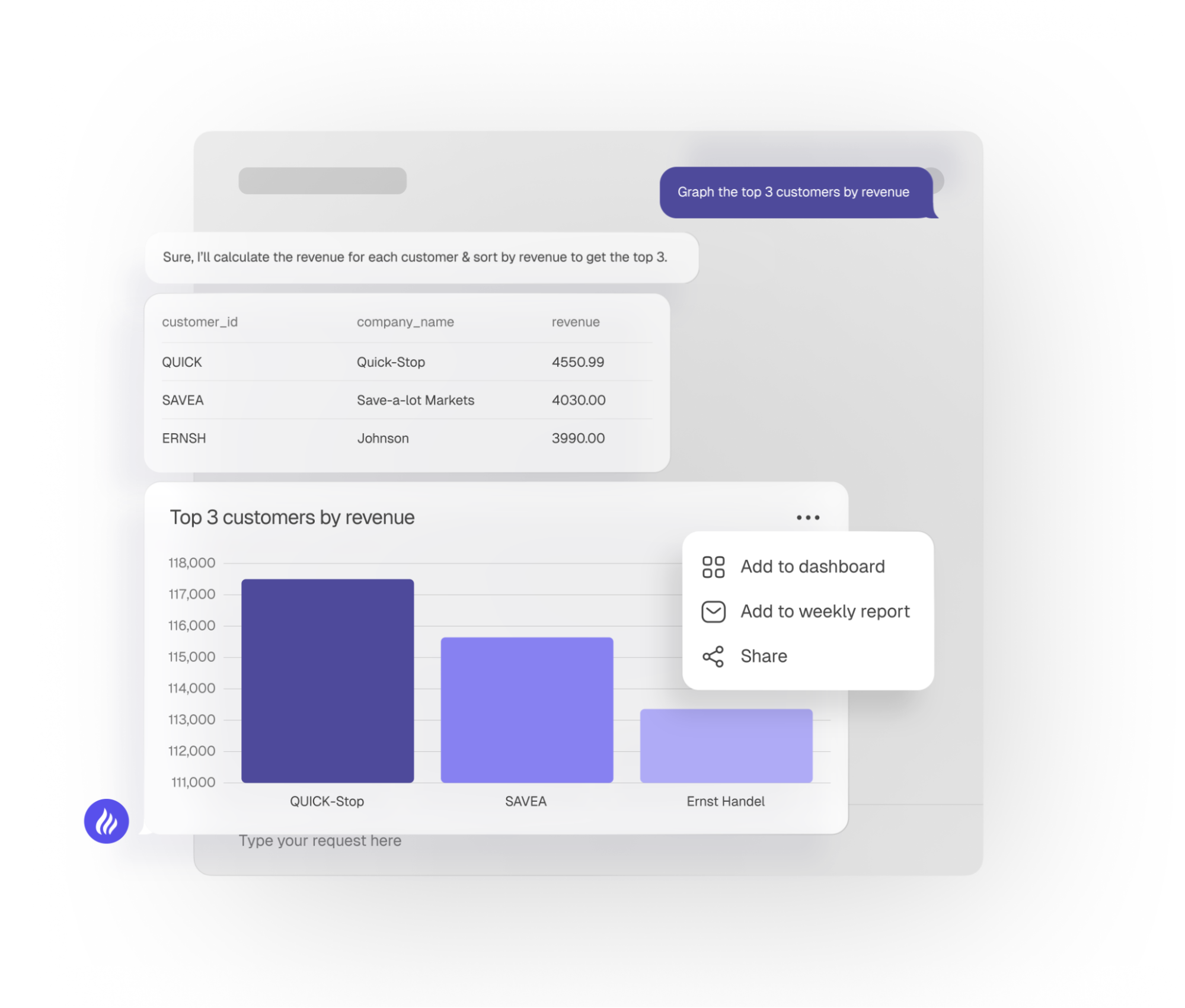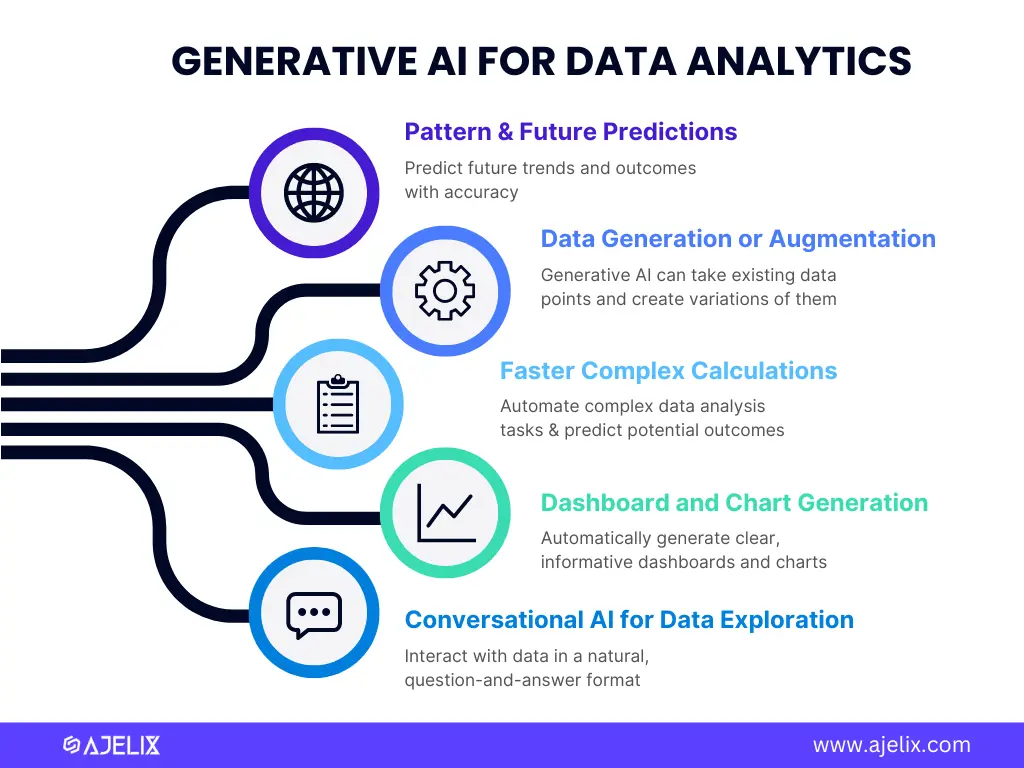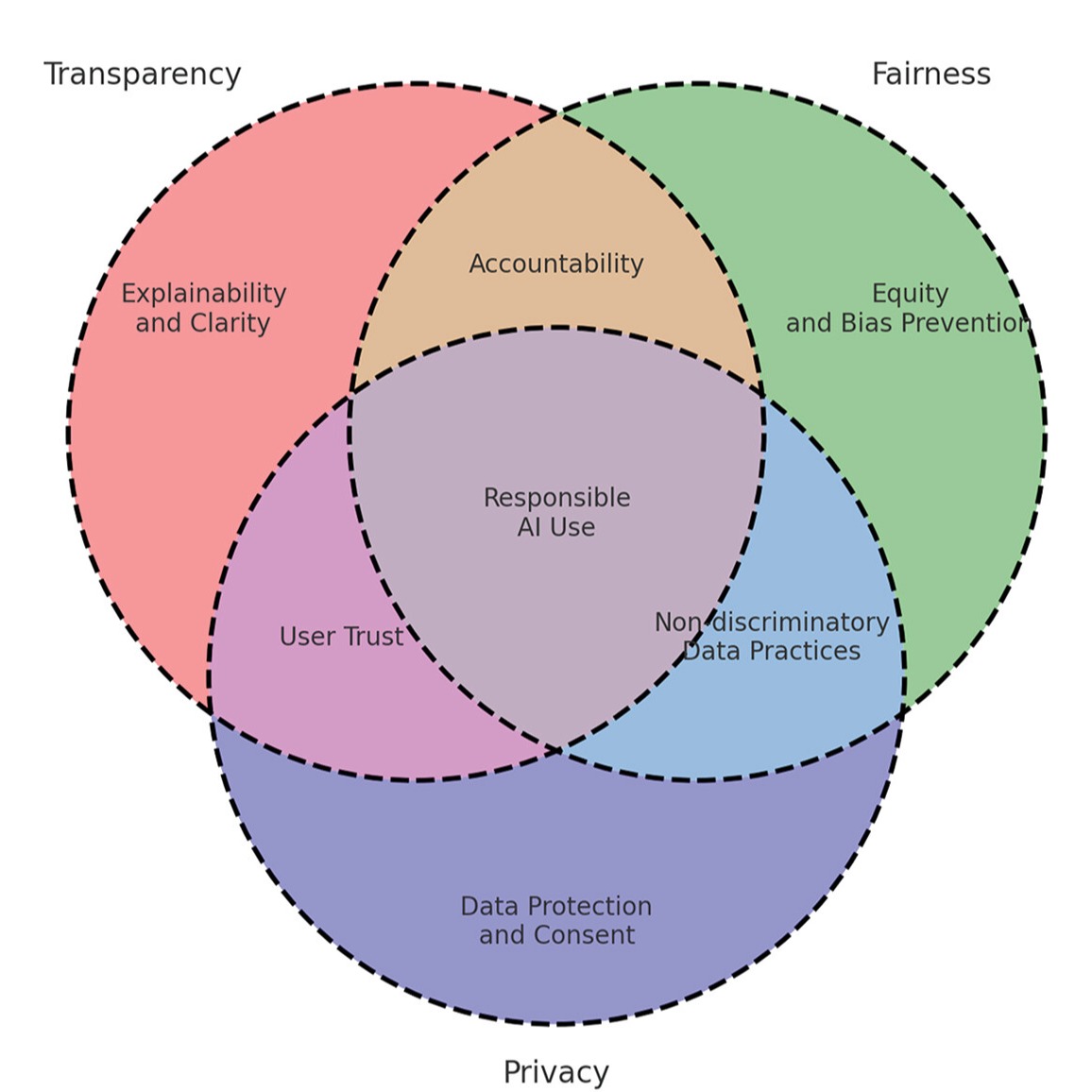Implementing Generative AI into Your Data Analytics Processes
Ever found yourself waiting on a data pull, stuck until someone with technical knowledge can surface the numbers and thought, “There’s got to be a faster way to get insights from this”? That is exactly the problem Generative AI solves in data analytics.
In this context, Generative AI refers to the use of large language models (LLMs) and machine learning systems to automate tasks like database querying, data cleaning, data visualization, dashboard creation, and even insight discovery. Instead of spending hours digging through datasets, teams can now ask simple questions such as, “Who are our top three customers by revenue?” and instantly receive a chart, a written summary, or even a recommended action.

From analysts and engineers to product managers and executives, everyone who touches data can benefit from faster access, deeper insights, and simpler interfaces. Non-technical users, in particular, gain the ability to explore and act on insights independently, eliminating the data‑request bottleneck and freeing specialists to focus on strategic goals.
In this article, we will explore:
- Why Generative AI is transforming analytics
- Key use cases where it creates value
- A practical roadmap for integration
- The best Generative AI tools for analytics teams
- Common challenges and future predictions
- Answers to frequently asked questions
Why Generative AI Is the Next Big Thing in Data Analytics?
Generative AI is changing how businesses analyze data by removing manual steps and opening access to deeper insights. From speeding up data preparation to generating dashboards and tapping into additional data sources, its impact is being felt across every stage of the analytics process.
Democratizing Access to Data Insights
Traditionally, only technical users could interact with data through SQL or dashboard tools. Now, regardless of skill level, team members can ask questions in plain English and receive accurate, data-backed answers. This shift removes the bottleneck of waiting on IT or data teams for every request. Marketing managers, sales leaders, and product teams can now self-serve insights.
This mirrors the shift discussed in our article on self-service analytics: empower individuals, reduce friction, and treat data as an organization-wide asset.
Accelerating Data Preparation and Transformation
Data preparation has traditionally been one of the most time-consuming stages, taking up to 80% of the analytics lifecycle. Teams often spend hours cleaning up missing values, formatting fields, merging data sources, and preparing files for analysis. Generative AI dramatically simplifies these steps. With a well-structured prompt, users can instruct the AI to detect anomalies, fix broken fields, recommend joins between tables, and even automate data transformations.
Data Stories, Not Just Dashboards: Generative AI That Explains What Matters
Accessing data is only the beginning. The real challenge lies in interpreting it and knowing what actions to take. Generative AI bridges this gap by producing dashboards, identifying trends, and summarizing insights in plain language. It can detect anomalies, explain fluctuations, and suggest next steps based on the data.
Imagine asking for a customer churn report. Instead of merely showing a chart, tools like BlazeSQL or Power BI Copilot will explain when the spike occurred, which segment it impacted, why it might have happened, and what should be analyzed further.
Generating Novel Datapoints From Previously Untapped Sources
Most teams already capture a gold mine of information, such as support tickets, chat transcripts, call‑log metadata, and narrative audit logs, but those records often sit idle in the warehouse because they’re messy, inconsistent, or simply too complex to summarize. Generative AI unlocks the potential of these unconventional sources, clustering thousands of descriptions into clear themes, surfacing objections, and summarizing step‑by‑step narratives to reveal bottlenecks or outdated tasks.
This data was once too complex to analyze at scale, but now Generative AI makes it both possible and practical. This means more context-rich decision-making for support, product, and operations teams.
Key Use Cases of Generative AI in Data Analytics
Generative AI is no longer just a backend innovation for data scientists. It is becoming a practical, everyday tool for business users, analysts, and decision-makers. Below are some of the most impactful ways organizations are currently applying it.

Conversational Data Querying
Generative AI enables users to query data conversationally, just as they might ask a colleague a question. There is no need to learn complex syntax or understand backend data models. Instead, users can ask questions like:
- “What were our top five performing regions last quarter?”
- “How has churn rate changed over the last six months?”
- “What is the average revenue from enterprise clients this year?”
The AI interprets these queries, translates them into the appropriate logic, and returns results in seconds. This encourages more frequent exploration and supports a more data-driven culture across departments.
SQL Query Generation Without Technical Knowledge
SQL remains a foundational tool in analytics, but not everyone has the skills to write or debug queries. Generative AI bridges this gap by converting plain-language requests into complete, optimized SQL statements. For example, a product manager might ask, “Find all users who signed up in March and used the social sharing feature,” and the AI will deliver a valid SQL query ready for execution.
These queries can handle advanced logic such as joins, filters, and aggregations, reducing the burden on data teams while increasing data access for everyone else. Rather than depending on analysts, this approach empowers more stakeholders to explore the data that matters to them independently.
Visualize Data Insights With No Code
Creating dashboards requires deep knowledge of data structures, chart types, and visualization tools. Generative AI simplifies that entire process. Users can now input a simple prompt, such as “show me monthly sales by product category for the past year”, and instantly receive a well-formatted, interactive dashboard.
Platforms like BlazeSQL, Power BI Copilot, and Tableau Pulse allow users to generate visualizations through natural language. These tools automatically identify relevant data, select chart types, and apply clean formatting without manual setup. This is especially useful for marketing, sales, or product management roles, where quick insights are essential but technical expertise is limited.
Enabling Real-Time Decision Making
Business agility relies on fast, informed decision-making. Generative AI speeds up this by delivering real-time access to key metrics and insights. Leaders can now self-serve analytics, eliminating the need to wait for end-of-week reports or build manual dashboards. They can simply ask questions and receive instant answers, enabling them to react quickly to customer issues, campaign performance, or supply chain changes.
This speed can compress decision cycles from days to minutes, giving organizations a competitive advantage.
Implementation Roadmap: How to Integrate Generative AI into Your Analytics Stack
Integrating Generative AI into your data analytics environment does not need to be complex or intimidating. Whether you are starting fresh or building on an existing BI infrastructure, the roadmap below outlines five essential steps to help you adopt AI-powered analytics effectively.

Step 1: Identify the Use Case and Target Users
Start by clarifying the specific problem you want to solve. Which team needs faster access to insights? What kinds of questions are they asking, and how often?
Focus on high-impact user groups such as
- Marketing teams evaluating campaign performance
- Sales teams tracking leads, conversions, and churn
- Operations teams monitoring fulfillment or inventory levels
Narrowing in on a clear use case helps ensure your implementation delivers immediate value rather than becoming a general-purpose tool no one adopts.
Step 2: Review Your Data Sources and Structure
Before layering AI tools onto your workflow, ensure your data infrastructure is prepared. While perfection is not required, a strong foundation will maximize the impact of Generative AI.
Checklist for readiness:
- Data is stored centrally (e.g., in a data warehouse like Snowflake or BigQuery)
- Datasets are clean, well-structured, and refreshed on a regular schedule
- Data ownership and governance protocols are clearly defined
By resolving structural issues early, you reduce the chance of poor AI outputs and inconsistent user experiences.
Step 3: Choose the Right Generative AI Tool
Your choice of AI tool should align with your goals. Are you looking to simplify reporting, automate SQL, or provide conversational interfaces?
Select platforms that:
- Integrate with your current data stack
- Support natural language inputs and context-aware querying
- Offer robust data privacy, governance, and access controls
The following section will explore five powerful tools that meet these requirements across different organizational needs.
Pro tip: As part of this selection process, create a small “test deck” of real questions from the pilot team. Attach the ground‑truth SQL and expected results for each prompt. Evaluating each generative AI tool against these curated examples lets you measure accuracy and assess performance.
Step 4: Roll Out to a Pilot Team
Start small by implementing Generative AI with one department or team. Provide access, offer training, and track results closely.
Pay attention to:
- Usability and adoption rates
- Feedback on AI-generated outputs
- Time saved on reporting and analysis
When the pilot proves valuable, other teams will naturally express interest. This approach builds momentum and allows you to expand usage without overwhelming support resources.
Step 5: Expand and Optimize Across the Business
Once the initial rollout has been validated, begin scaling the solution across additional teams and workflows.
Key optimization areas include:
- Adding new data sources and dashboards
- Customizing AI prompts or logic to reflect internal language
- Monitoring usage patterns to identify friction points or underutilized features
You can also begin measuring ROI by tracking time saved, decision speed, and engagement levels across teams. These metrics will help guide further improvements and justify future investments in your data stack.
5 GenAI Tools You Can Integrate Into Your Data Analytics Stack
Choosing the right Generative AI tools can make or break your analytics transformation. Below are five standout platforms that integrate seamlessly into modern analytics stacks, each offering unique capabilities to suit different teams and business needs.
1. BlazeSQL
BlazeSQL is a modern, AI-powered analytics platform that makes querying and exploring data more effortless through natural language. It’s designed for companies that already keep their data in SQL databases, such as Snowflake, BigQuery, Redshift, SQL Server, and more.
Key features include:
- Ask plain language questions and get visual answers
- Recommend a relevant visualization
- Enterprise-level security
- Embedded analytics capabilities for application integration
- AI-generated summaries and insights directly within dashboards
- AI-generated email reports
- Slack Integration
BlazeSQL is ideal for organizations looking to democratize analytics while maintaining flexibility and control.
2. Power BI
Power BI Copilot brings the power of Generative AI into the Microsoft ecosystem, making advanced analytics more intuitive for business users.
With Power BI Copilot, users can:
- Natural language querying for basic requests
- Generate DAX expressions automatically
- Summarize data trends and key takeaways
- Suggest filters and drill-down paths interactively
3. Zoho Analytics
Zoho Analytics leverages AI to deliver fast, flexible business insights across teams.
Its AI assistant, Zia, allows users to:
- Query data using natural language
- Generate reports and charts with minimal effort
- Detect anomalies in real time
- Receive predictive recommendations based on data trends
4. Tableau
Tableau Pulse and Tableau GPT are the newest additions to Tableau’s analytics ecosystem. They introduce natural language and proactive intelligence to the platform.
With Tableau’s Generative AI features, users can:
- Automate insight discovery across datasets
- Create narratives that explain patterns and anomalies
- Receive real-time alerts about data shifts
- Use voice or text to explore and interact with dashboards
5. Qlik
Qlik combines Generative AI with its established strength in data integration and real-time analytics.
Its AI capabilities enable users to:
- Integrate with OpenAI to surface contextual insights
- Automate app workflows and reporting tasks
- Generate visual explanations and trend analyses instantly
Challenges and Ethical Considerations
While Generative AI introduces remarkable speed and accessibility into data analytics, it also brings significant challenges and ethical implications. Organizations adopting these tools should proceed with optimism and caution, understanding the trade-offs and responsibilities of AI integration.

Data Privacy and Security
Feeding sensitive business data into AI platforms carries inherent risks. Improperly configured systems may store, leak, or expose private information, especially when using public or third-party large language models.
To protect enterprise data:
- Use platforms that offer robust access control, encryption, and audit trails.
- Avoid sending proprietary or regulated data to open or unsecured models.
- Consider deploying private LLMs hosted on secure, internal infrastructure.
Accuracy and Output Consistency
Generative AI is not deterministic. The same prompt may yield slightly different outputs across sessions. While this is acceptable in creative use cases, it poses problems in analytics, where consistency, traceability, and auditability are essential.
To mitigate this risk:
- Always validate AI-generated outputs before acting on them.
- Implement guardrails and use tools that support versioning and production review.
- Pair AI-generated insights with human oversight and logic checks.
Bias in AI Outputs
AI systems are only as fair as the data on which they are trained. If historical data contains demographic, geographic, or behavioral biases, the AI may replicate and even reinforce those patterns. This can lead to skewed insights or unfair decision-making processes.
To address bias:
- Use diverse, high-quality datasets in model training.
- Regularly audit AI outputs for signs of bias or imbalance.
- Employ bias detection tools and involve diverse human reviewers during implementation.
Model Transparency and Explainability
Many large language models operate as “black boxes,” meaning users receive outputs without understanding how or why those answers were generated. Within regulated industries, this lack of transparency can be a severe liability.
Organizations should prioritize tools that:
- Provide visibility into how prompts are interpreted
- Log queries, model behavior, and transformations
- Enable users to trace insights back to the source data and logic
If an AI system cannot explain its output so humans can understand, it may not be ready for enterprise deployment.
Ethical AI Use
Not everything that can be automated should be. Generative AI should enhance, not replace, human analysis, especially when insights affect people, finances, or compliance decisions. Use AI to increase speed and scale, but keep human judgment in the loop for interpretation, strategy, and final decision-making.
The World Economic Forum and the Organization for Economic Co-operation and Development (OECD) have released comprehensive frameworks around responsible AI use for further guidance. These include principles on transparency, accountability, and user empowerment that organizations can adapt to develop their own internal AI ethics policies.
The Future of Generative AI in Data Analytics
Generative AI is reshaping how businesses interact with data. Teams no longer have to rely entirely on analysts or engineers to get insights. With tools like BlazeSQL, they can ask questions, explore data, and make decisions faster.
A major benefit is the time it saves. “BlazeSQL helps us automate SQL writing and saves hours each week,” says Brady Caspar, CTO of hoo.be.
Additionally, this speed is helping teams respond to customer needs more effectively. “We reach insights faster and can test ideas without relying on engineers,” adds Sej Sander Thorsen, Chief Product Officer at Klarpris.
Generative AI fills a critical gap for teams looking for fast answers without building complex reports. “Sometimes, you just need a quick answer or a place to start,” explains Thibaut Nguyen, CTO of Poppy Mobility. “BlazeSQL gives us that and saves time.”
Looking ahead, Generative AI will continue to make analytics more accessible. It will help more people ask the right questions, find insights faster, and act confidently. The future of data is not just about having more of it, but about giving more people the ability to use it well.
Drive smarter decisions today
Frequently Asked Questions
What is Generative AI in the context of data analytics? Generative AI in data analytics refers to using artificial intelligence models, particularly large language models, to generate text, queries, summaries, charts, and insights from structured or unstructured data. It enables users to ask questions in natural language and receive actionable results without writing code or manually analyzing datasets.
Can Generative AI replace human analysts? No. Generative AI is a powerful assistant, not a replacement. It speeds up data preparation, report generation, and basic trend analysis. However, it lacks human judgment, business context, and strategic insight. Human analysts are essential for interpreting outputs, making decisions, and guiding business strategy.
How is Generative AI used in business intelligence? Generative AI enhances business intelligence by simplifying data exploration, automating report creation, and making insights accessible through natural language. It allows users to ask questions, generate dashboards, identify patterns, and receive recommendations without needing deep technical skills or extensive training in BI tools.
Is Generative AI safe for enterprise data environments? Yes, if implemented responsibly. Enterprises should choose platforms with strong security measures, including encryption, role-based access, and data governance features. Avoid sending sensitive data to public models unless you fully understand and trust their privacy practices. Many organizations opt for private or hybrid AI deployments to maintain data control.
Will Generative AI make analytics more accessible to non-technical users? Absolutely. One of the most transformative aspects of Generative AI is how it lowers the barrier to entry for data analytics. Non-technical users can ask questions, build reports, and understand trends using natural language instead of code. This democratizes data and enables company-wide participation in decision-making.
Additional reading sources
- https://www.gartner.com/en/data-analytics/topics/ai-for-data-analytics
- https://www.weforum.org/stories/2024/10/strategies-for-using-generative-ai-to-responsibly-extract-data-insights/
- https://www.forrester.com/technology/generative-ai/
- https://www.oecd.org/en/topics/sub-issues/generative-ai.html



